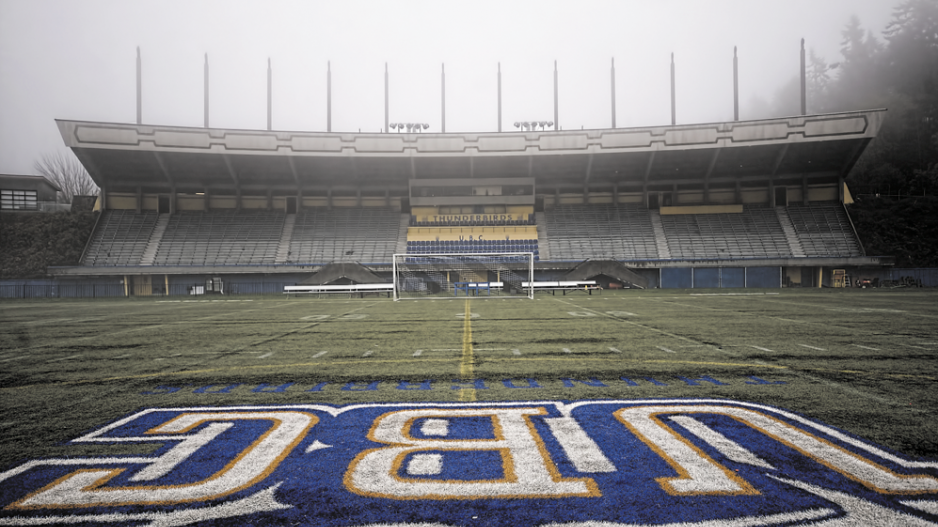Will it be renovation or relocation for University of British Columbia’s Thunderbird Stadium?
The future of the 50-year-old home of the university’s U Sports (formerly Canadian Interuniversity Sport) football team and the United Soccer League’s Whitecaps FC2 is being studied by UBC staff, with a report expected to be submitted to the board of governors in February.
A 2009 study recommended it be updated and a 2012 study recommended a seismic upgrade. Now, UBC planning and athletics staff are eyeing the land for residential redevelopment to help pay for an overhaul of UBC’s spectator and recreational hubs.
Five options are on the table for the stadium that was built in 1967, Canada’s centennial year: keep the stadium and renovate it for $10 million or more; build a new stadium beside it, at Whit Matthews Field, for $80 million; build a new stadium at Rashpal Dhillon Track and Field Oval, and move the oval to Whit Matthews Field ($85 million); build a new stadium at the Osborne Centre and Tennis Bubble site for $105 million; or a hybrid option of a new stadium on Whit Matthews Field and an Athletics Centre of Excellence at the Tennis Bubble. The hybrid option would cost $30 million for the new stadium and $50 million for the athletics centre.
Michael White, UBC’s associate vice-president of campus and community planning, explains that the stadium is in an area identified as the future Stadium Road Neighbourhood. Whit Matthews Field was supposed to be one of the fields in the Whitecaps’ National Soccer Development Centre training complex, but plans were changed in 2013.
White said UBC is halfway through the consultation process on its 20-year facilities strategy. He said the list of options could be shortlisted before the process ends. A capital decision is not expected until some time after February.
“It’s not about the board making a capital allocation decision. We want to paint the scenarios about what the future funding and financing could be, to inform the board as this strategy is completed,” White said.
The stadium received a new $1.8 million Polytan synthetic turf surface in 2010 and, in 2015, the addition of the $1.1 million UBC Football Academic Centre. Kavie Toor, director of facilities and business development, said both recent investments would be considered, along with the stadium’s historical significance. However, the UBC planning website pointed to various drawbacks, such as dressing rooms not being at field level, some poor sightlines and separation from the rest of Thunderbird Park and athletics amenities.
According to the website, both Thunderbird Stadium and the War Memorial Gym “have significant deferred maintenance and require extensive accessibility and functional upgrades.” It contemplated two hubs: one for recreation sports and the other for spectator sports.
Funding could be one, or a combination, of three options: internal, through department revenue and fees; external, from government, donors and sponsors; or land value opportunities from moving the stadium and redeveloping the Stadium Road Neighbourhood.
“The opportunities for increased revenue from land development [are] only available by moving the existing Thunderbird Stadium. The facilities strategy funding options include the typical internal and external funding sources available for UBC capital projects, as well as a unique opportunity to access additional land value funding from the Thunderbird Stadium option,” states the web page, titled “Tradeoffs and Strategy Implementation.”
Toor said the UBC situation is particularly acute. UBC, which asked for public input October 3-23, claims it has only 0.15 square feet of recreational floor area per student, trailing Simon Fraser University (0.47) and University of Victoria (1.08).
The report said UBC needs three recreational gym courts, 35,000 to 40,000 square feet of new fitness space and 10,000 square feet of support space. For the spectator hub, the wish list includes a 5,000-seat stadium and multipurpose field space; a new Athletics Centre of Excellence to replace the War Memorial Gym; and expanding the baseball stadium to 1,000 seats with the potential to add more.
The stadium’s cantilevered roof, designed by architect Vladimir Plavsic, and the 12 towers depict a stylized thunderbird from a Bill Reid mould, according to a heritage statement.
A proposed strategy is expected to be presented to the board of governors, which includes UBC football booster David Sidoo, for approval in spring 2017. While Wesbrook Village remains more than two years from being completed, White said the neighbourhood planning process is focused on the stadium situation.
“We have strong demand for housing out here and a real desire to improve opportunities for faculty and staff living on campus,” White said. •




